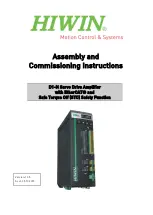
Presentation
Current management on the power supply units (Lifextender) ®
This is activated when the maximum current rated for continuous operation of the power
supply is exceeded� This value is lower than deliverable current limit and represents the
threshold which can be exceeded only for short periods (maximum 1 minute each time)�
If this situation occurs, the “PSU current derating” function is activated (alarm “013” and,
if necessary, alarm “014”) and the ALC management algorithm, running in correct wor-
king mode, is replaced by another one wherein the VDS and Bias are determined by the
user settings� The current delivered by the power supply units has the highest priority in
this case�
The current derating is deactivated when the power delivered rises to the value set by
the user if the maximum current provided by the power supply units is less than or equal
to the maximum value allowed for continuous operation�
Thermal management on the power supply (Lifextender) ®
The power supply management algorithm works according to the temperature like that
on the RF unit and is logically connected in “OR” to it�
The first derating level (acting directly on the output power) is activated when the power
supply temperature exceeds 75°C, while the second level is activated - when the first is
ineffective - if the temperature does not stabilize below this value� In the last case, the
output power is decreased of – 3 dB via the same procedure described for the RF section�
The activation of this feature is shown on the display and via telemetry as alarm no�
“015” and possibly no� “016”�
Fault Management on the RF modules (Lifextender) ®
It manages the maximum deliverable output power according to the number of correct
working RF amplifier modules�
If one or more MOSFETs are considered faulty (this happens when their absorbtion is
10% below the average value), the RF output power is reduced to the expected value
when occurs this kind of fault and the fans speed is pushed to the maximum rate� The
fault cases and the corresponding maximum power reacheable levels are described by
a complex table obtained via many tests� It is designed to stop the fault spreading and
to prevent the MOSFETs that are still working from excessive stress by the ALC algorithm
(which would require them to provide all the missing power output)�
In order to avoid an excessive number of alarms, no messages are sent when an alarm,
if validated, occurs after the adjusting of the output power according to the parameters
in table, and only if the -3dB condition is present�
The activation of this feature is shown on the display and via telemetry as alarms no�
“008” and no� “009”�
27
Summary of Contents for E10000X
Page 3: ...3 Revision N Date Description 00 01 12 2016 First release Revision Preliminary...
Page 6: ...6 Index...
Page 10: ...10 Informative letter...
Page 14: ...14 Identification...
Page 30: ...30 User instructions...
Page 50: ...50 User instructions...
Page 54: ...54 User instructions...
Page 58: ...58 User instructions...
Page 60: ...60 WEB interface...
Page 72: ...72 WEB interface...
Page 104: ...104 WEB interface...
















































